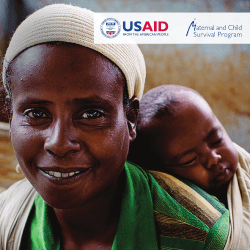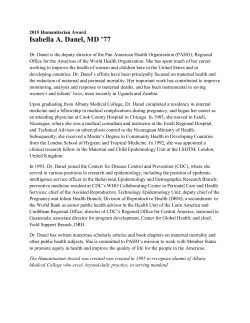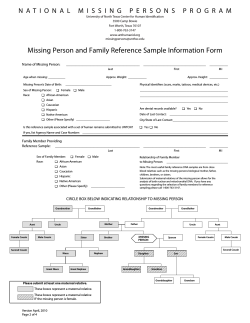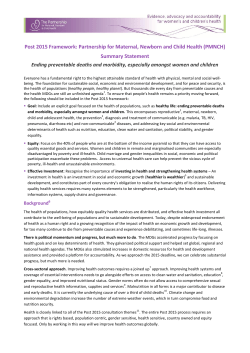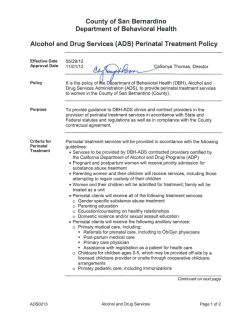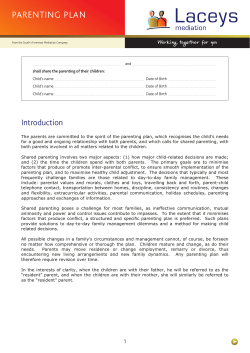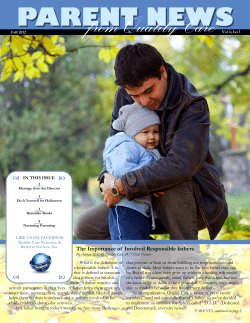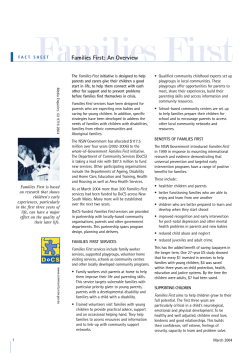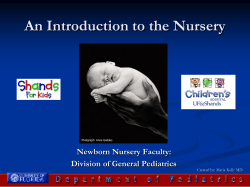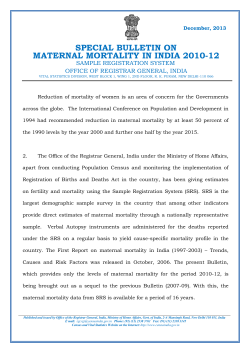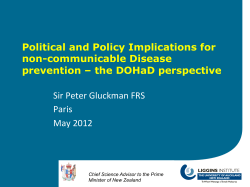
Why an Under 5’s program? Infant Mortality Rate 1986- 2003
Why an Under 5’s program? Tina McKinnon and Lesley Nuttall Maternal Child and Youth Health CARPA Conference Katherine 2009 Influences that impact on child health and well being The larger social, structural Family Ecological approach Picture of Child Health in the NT Infant Mortality Rate 1986- 2003 No. deaths per 1000 livebirth School NT Indigenous rate – 15.2 50 Indigenous Non-Indigenous Australia Children Economic Political Community NT Non-Indigenous – 6.3 40 Australian – 4.8 30 20 and Cultural Environment Infant Mortality Rate is the number of deaths among children aged less than one year per 1,000 live births. 10 20 03 20 01 20 02 19 99 20 00 19 98 19 96 19 97 19 94 19 95 19 92 19 93 19 91 19 89 19 90 19 87 19 88 0 19 86 Zubrick et al, may 2000 Year Picture of Child Health in the NT 1. Perinatal conditions 2. Congenital malformations Causes of Infant Mortality 1998 - 2002 Number of deaths per 1000 livebirths 1200 NT Indigenous NT non-Indigenous Australia 3. Ill-defined symptoms and signs (inc. SIDS) 1000 Picture of Child Health in the NT Causes of infant mortality for conditions originating in the perinatal period 1998 - 2002 Number of deaths per 100 000 livebirths 500 NT Indigenous NT non-Indigenous Australia 450 400 4. Injury and poisoning 5. Nervous and sense organ diseases 400 6. Respiratory diseases 4. Perinatal infections 250 200 5. Haemorrhagic and haematological disorders 150 100 7. Circulatory diseases 50 0 P erinat al co nditio ns Co ngenital malf ormat ions Ill-defined s ympto ms and signs Injury and poiso ning Nervo us system and sens e organ diseases Respirato ry diseases Circulato ry diseas es Infect ious and parasitic dis eases Neo plasms From Infancy to Adulthood, 2006 8. Infectious and parasitic diseases 9. Neoplasms 2. Other respiratory conditions 300 200 0 1. Newborn affected by maternal conditions 3. Prematurity 350 800 600 From Infancy to Adulthood, 2006 New born af f ected by maternal conditions Other respiratory conditions Prematurity Perinatal inf ections Haemorrhagic and haematological disorders Intrauterine hypoxia and birth asphyxia Other From Infancy to Adulthood, 2006 6. Intrauterine hypoxia and birth asphyxia 7. Other 1 Picture of Child Health in the NT Causes of death in children aged 1-14 years, 1998 to 2002 Number of deaths per 100 000 livebirths 25 NT Indigenous NT non-Indigenous Australia 20 1. Injuries and poisoning 2. Infectious and parasitic diseases 3. Circulatory diseases 4. Neoplasm 15 5. Respiratory diseases 10 6. Nervous and sense organ diseases 5 0 Injuries and poisoning Inf ectious and parasitic diseases Circulatory diseases Neoplasm Respiratory diseases Nervous system and sense organ diseases Ill-defined symptoms and signs Mental disorders Other 7. Ill-defined symptoms and signs 8. Mental disorders From Infancy to Adulthood, 2006 Picture of Child Health in the NT NT KEY CHILD HEALTH INDICATORS – Infant Mortality Rate falling but remains 3x non-Indigenous rate – Low Birth Weight 2x non-Indigenous rate – High rate of infections, skin, chest, gastro – High rates malnutrition and anaemia – Higher rates of child abuse and neglect more under 4 years – Post streptococcal disease ARF/RHD and PSGN – Otitis media – S.T.I From Infancy to Young Adulthood (2006) 9. Other What the Australian Government Intervention found? KEY CHILD HEALTH INDICATORS; SIDS Risk 5X higher 77% smoker in household 71% bed sharing 37% tobacco smoke exposure Growth 10% stunted 20% underweight 5% wasted 5% overweight 33% soft sleeping surfaces Illness Immunisations 41% Untreated caries 29% Ear disease 16% Anaemia 10% Skin sores 8% Scabies 16% Immunisations due History of the Under 5’s Program Development 2003 - Change in political will – NT labour govt funding for MCYH 2003 - Medicare bundles of care proposed change in funding structures 2005 - Employment of project officers to review best practice evidence 2005/6 - Development of Under 5’s Working party – cross divisional MCYH, Community Paediatricians (Central and Top End), Paediatricians, AMSANT, RANs, Remote Health, Community Care, Office of Aboriginal Policy, PPN, DMO’s, Women’s Health, FACS, CDU, SWSBSC plus others from time to time 2008 - Pilot of Assessment tool in 5 communities Oct 2008 - AGI – Phase 3 “Roll out under 5’s program in 3.5 months” Dec 2008 - Employ second project officer – Lesley July 2009 – Roll out of Healthy Under 5 Kids program NTER-OATSIH- May 08 Importance of the Early Years – Risk Factors Issues for consideration in planning Primary health care team approach High level of health needs of general population Cultural differences in child rearing practices Workforce Issues Priority of emergency care, adult health etc Remote Staff have multiple roles Few resident doctors Shortage of AHWs Little capacity to devote more time to child health Few RANs trained in Child Health High staff turnover Other programs Consistency with other documentation Poor Health Care Poor Housing Negative Social Networks Limited Employment Young Maternal Age Substance Abuse Depression or other Mental Illness Inappropriate Age Expectations Of a child Marital Disharmony Lack of Stimulation Of Child Single Parent Low Level Of parental Education Family & Parents & their parenting style Rejection Of Child Large Family Harsh or Inconsistent Parenting Lack of Warmth & Affection Birth Spacing Lack of Support Services Disorganised or violent Communities Socio Economic Disadvantage Poor Public Transport 2 Importance of the Early Years – Protective Factors Good Health Care Adequate Housing Positive Social Networks “meaningful” Employment Antenatal care Good Maternal health Supportive Relationships with other adults Marital harmony Breast Good feeding problem solving Healthy skills lifestyle Parental Education Family & Parents & their parenting style Attachment To family Small family size Consistent Parenting/ carers Father’s involvement in parenting Birth Spacing Access to Support Services DOCUMENTATION Paper based forms or PCIS 0-4 yr care plan Strong, Safe Communities • Anticipatory guidance points Economically independent / adequate funds used throughout the documents Public Transport Risk Assessment Social and Emotional health Cultural identity and pride Components of the Healthy Under 5 Kids Schedule Continuity of care: preconception – maternal – birthing – child – youth – adult health Anticipatory Guidance: age appropriate education and support Social and Emotional health Child Development Early identification and management of common health problems, such as ear disease and oral health Child Growth and Nutrition Components - Child Growth and Nutrition Components - Anticipatory Guidance Integrate age appropriate health promotion messages at key contacts Continue with GAA schedule Limit to a couple of key message per visit. Encourage 2 weekly weighs until 2 months (8 week check) • So not to Overload Encourage monthly weights till 2 years (previously was 3 years) • One-to-one advice does it work? From 2 – 4 years - 6 monthly weight, height and haemoglobin • Monthly recall only for higher risk Use Action Plans if a child is not growing well No evidence based research at present but experts are supportive • Priority areas identified and we will need to evaluate the impact 3 Components - Anticipatory Guidance Oral Health – – – SIDS Maternal oral health important Lift the Lip Value of baby teeth - teeth cleaning and diet Injury prevention – – – – – Safe sleeping practices No smoking around infants and children Not co-sleeping when using alcohol or drugs A story from the field………. Hygiene Watch children around water, fires, falls, Use of appropriate vehicle child restraints (Kidsafe – – – report, 2005) Wash babies at least every second day Appropriate rubbish disposal Tissue spears Promote, play and development and reading – – – Encourage play and interaction between child, parents and carers Link in to supported play groups/ Jet crèches pre-schools etc Encourage reading to children – – – Exclusive Breast Feeding until 6 months Introduction of solids at 6 months 3 meals, 2 snacks per day for older children Vaccination Parenting – Nutrition messages Support parents in their role as primary carers – – Follow NT Childhood vaccination schedule Timeliness important Medicare Item 708 Resources - Healthy Under 5 Kids Aboriginal and Torres Strait Islander Child Health Check Paperwork - Assessment forms, wall planner, work plan • • • • • PCIS – Under 5, Healthy Under 5 Kids Care plan, Training, Central Doctors & RAN’s, AHW’s can share the workload Child must be seen by a doctor Annually, but can be 9 months between checks Early identification and treatment of infections Evaluation of this?? User reference guide (URG) - developed Resources – Resource folder, Online – Remote Atlas, Clinical Manual? Training/Education - Self directed learning package by MCYH & CDU, Can an annual health check improve outcomes? • Need more contacts during early years • Incremental yield of same check on a child every year likely to be low • Amounts to approx 16,000 (for all NT children) remote consults per annum, workforce issues and opportunity costs • Estimated revenue – funding source? Practical Paediatrics, Face to Face workshops Rationale document – to be reformatted Ongoing Evaluation – Pilot phase, Implementation phase, Outputs and Outcomes Contact List Director MCYH Sharon Haste 8985 8122 MCYH HU5K Project Team Lesley Nuttall 8985 8029 Tina McKinnon 8985 8047 MCYH Top End Coordinator Karen Doyle 8922 7816 MCYH Central Coordinator Kevin Orrell 8955 6105 MCYH Top End Administration Vicki-ann Buck 8922 7712 MCYH Central Administration Anne Marie Pearce 8955 6102 4
© Copyright 2025
